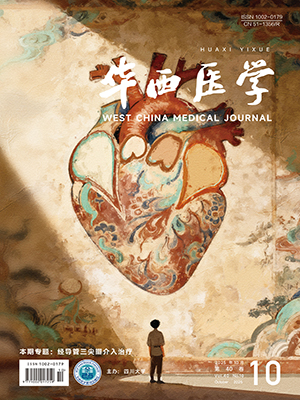| 1. |
陈斌. 3000例神经内科门诊患者的病种分析[J]. 河南实用神经疾病杂志, 2003, 6(1):49.
|
| 2. |
覃玫, 吴霖浦, 李小蜂, 等. 神经内科门诊3500例患者病种分析[J]. 华夏医学, 2008, 21(2):250-251.
|
| 3. |
刘树东, 张波. 神经内科门诊患者的病种分析[J]. 中国医药指南, 2014(22):213-213.
|
| 4. |
罗祖明, 罗滢. 1000例神经内科门诊患者分析[J]. 华西医学, 1997, 12(1):46-47.
|
| 5. |
范肖冬. ICD-10国际疾病分类[M]. 北京:人民卫生出版社, 1993.
|
| 6. |
尚莉, 李燕, 李健, 等. 工作压力对不同性别职业人群身心健康影响[J]. 中国公共卫生, 2008, 24(12):1519-1521.
|
| 7. |
杨雪, 王淇田. 中国人口老龄化趋势地区性差异的量化分析[J]. 吉林大学社会科学学报, 2012(1):148-153.
|
| 8. |
陈小春. 四川省城镇居民消费水平和消费结构的实证分析[J]. 商场现代化, 2007(35):4-5.
|
| 9. |
谢坚刚. 老年人在医保改革中面临的风险与对策[J]. 社会, 2002(2):7-9.
|
| 10. |
黄朝真, 艾春启. 神经内科门诊头痛患者分型分析[J]. 药物与人, 2014, 27(6):267.
|
| 11. |
王小泉, 宋传福, 杨筠. 不同时期精神科门诊初诊病人的临床特征分析[J]. 四川精神卫生, 2009, 22(1):19-22.
|
| 12. |
沈渔邨. 精神病学[M]. 北京:北京医科大学出版社, 2002:627-654.
|
| 13. |
李晓佳, 孙红斌, 黄雨兰, 等. 成都市三级综合医院神经内科门诊就诊者抑郁/焦虑患病率调查[J]. 实用医院临床杂志, 2011, 8(4):64-66.
|
| 14. |
王大模, 文世全, 张玲燕, 等. 神经内科门诊患者的病种分析[J]. 西部医学, 2012, 24(6):1110-1111, 1114.
|
| 15. |
杨双会, 雷静, 张会君. 门诊导医服务与对策[J]. 华西医学, 1999, 14(2):211.
|




